Jewish History and Historical Fiction Books for Children (Page 2) |
If you wish to purchase any of these books, click on either the title or the book cover to be directed to Amazon.com. As a warning, I have put up pictures of the book covers to give you somewhat an idea of the style of each book (I know, I know. "Don't judge a book by its cover") so the pages may load slowly, depending on the speed of your internet connection.
If this page came up without frames, Click here to see the complete website
For history books for older readers, go to the History Books for Middle School and YA Readers Page
For historical fiction books for older readers, go to the Historical Fiction Books for Middle School and YA Readers Page
Other Pages of Interest:
Children's Jewish History and Historical Fiction Books
(Page 1) |
(Page 2) |
(Page 3) |
(Page 4) |
Easy Reader and Picture Books:
Jewish Children's Books (General) |
Jewish Board Books |
Biblical Stories for Children |
Jewish Holiday Books |
Jewish Family Cookbooks |
Folktales and Talmudic Stories for Children |
Jewish Life Books (Mitzvot, Keeping Kosher, etc.) |
Jewish Life Cycle Books |
Family Haggadahs |
Children's Prayerbooks |
Introductory Hebrew Books |
Jewish History and Historical Fiction Picture Books |
Israel Books
Middle School and YA Books:
Bar Mitzvah Books |
Jewish Fiction |
Historical Fiction |
Torah Study |
Prayer and Jewish Life Books |
Jewish Holidays |
Jewish Biographies |
Jewish History Books |
Holocaust Books for Teens |
Israel Books
Jewish Children's Books |
Bar Mitzvah Books |
Jewish Parenting Books |
Jewish Music for Children |
Jewish Children's Videos |
Jewish Jewelry
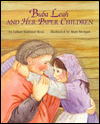
Buba Leah and Her Paper Children
By Lillian Hammer Ross
With its Fiddler on the Roof setting and unabashedly
sentimental story line, this warmly evocative tale presents
a glimpse of the Jewish immigrant experience. Chava is
curious about her next-door neighbor and great-aunt,
Buba Leah. She's often heard her say how she exchanged
her offspring for "paper children.'' When Chava finally
musters her courage to ask about them, she finds they
aren't actual children, but the letters written to Buba Leah
by her children in America. One day a letter arrives containing
two tickets--one for Buba Leah and one for Chava--and,
in a poignant finale, the two depart for a new life. Chava's
parents are left with Buba Leah's empty wooden box,
which they will soon fill with their own "paper children.''
Ross's simple story is as satisfying as Sabbath challah,
and Morgan's earthy illustrations render village life and
the special bonds between family members in an
affectionate light.
Description from Publisher's Weekly
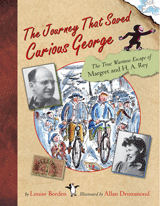
The Journey That Saved Curious George : The True Wartime Escape of Margret and H.A. Rey
By Louise Borden
Everybody loves Curious George, the mischievous monkey, but few know the harrowing story behind his creators' narrow escape from Paris just hours before the Nazis seized control of the city. In 1940, Hans and Margret Rey had to flee their home as the German army advanced. They began their journey to freedom on bicycles, pedaling to southern France with their children's book manuscripts among their few possessions. One of these manuscripts went on to become Curious George, the tale of that inquisitive monkey who is one of the most enduring characters in children's literature. The Reys' story is now told in dramatic detail in The Journey That Saved Curious George.
Louise Borden combed primary resources, including Hans Rey's pocket diaries, to tell this dramatic story. Archival materials — photographs, train ticket stubs, letters and cards — introduce readers to the world of Hans and Margret Rey, and Allan Drummond dramatically and colorfully illustrates their wartime trek to a new home. Follow the Reys' amazing story in this unique large-format book that resembles a travel journal; see for yourself the route the Reys took as they traveled to freedom.
Description from Publisher
A new book, The Journey That Saved Curious George: The True Wartime Escape of Margret and H. A. Rey", tells of how George's creators, both German-born Jews, fled from Paris by bicycle in June 1940, carrying the manuscript of what would become Curious George as Nazis prepared to invade. ... Her account, intended for older children, is illustrated in whimsical European style by Allan Drummond, and includes photographs of the Reys and wartime Europe, as well as H. A. Rey's pocket diaries and transit documents.
Description from The New York Times
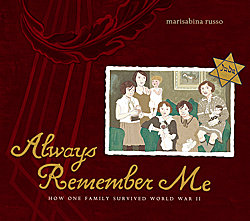
Always Remember Me: How One Family Survived World War II
By Marisabina Russo
Awards:
- AJL Sydney Taylor Book Award Notable Book
- Bank Street Best Books of the Year
- ALA Notable Children's Books
- School Library Journal Starred Review
Rachel's Oma (her grandmother) has two picture albums. In one the photographs show only happy times -- from after World War II, when she and her daughters had come to America. But the other album includes much sadder times from before -- when their life in Germany was destroyed by the Nazis' rise to power.
For as long as Rachel can remember, Oma has closed the other album when she's gotten to the sad part. But today Oma will share it all. Today Rachel will hear about what her grandmother, her mother, and her aunts endured. And she'll see how the power of this Jewish family's love for one another gave them the strength to survive.
Marisabina Russo illuminates a difficult subject for young readers with great sensitivity. Based on the author's own family history, Always Remember Me is a heartbreaking -- and inspiring -- book sure to touch anyone who reads it.
Description from Publisher
The experiences of Russo's relatives before, during, and after World War II are the basis for this story about a grandmother sharing with her young granddaughter photo albums of her "first life" (in Germany) and her "second life" (after the war). Rachel's family gathers for Sunday dinner at Oma's. After the meal, Oma tells the girl of her marriage and her family's happy life; her husband's death after World War I; the rise of the Nazi party and denial of rights to Jews; the burning and looting of Jewish businesses; and life in a concentration camp. At war's end, Oma and her three daughters were reunited in America. Now she gives Rachel the gold heart necklace that her own grandmother gave her many years ago when her family left Poland for Germany ("When you wear this…always remember me and…May luck follow you wherever you go"). This book introduces the Holocaust in a simple but factual narrative that can be easily understood by youngsters who have no knowledge of World War II. Gouache illustrations in Russo's familiar folk style are accompanied by many re-creations of old photos, government papers, money, an identity card–all helping to bring the events to life. Photos on the endpapers show the author's family. This offering answers the need for appropriate Holocaust literature for young children and should be considered a first purchase.
Description from School Library Journal
In a moving picture book, Russo tells her Jewish family's story of Holocaust survival. She remembers herself as a small child visiting her grandmother, Oma, who tells Russo the family history with photos stretching back to Oma's youth and marriage before World War I. Children will need help to understand the multigenerational time frame and to keep track of who's who; in fact, the book may appeal more to adults than to young readers. But Russo personalizes the history with photo-album entries printed on the endpapers, and her gouache illustrations, framed like photos, show the individuality and strength of family members as they faced the Nazis who sought to destroy all Jews. Miraculously, Oma and her three daughters, two of whom were in the camps, survived to be reunited in the U.S. An afterword fills in some Holocaust history.
Description from Booklist
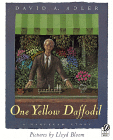
One Yellow Daffodil :
A Hanukkah Story
Awards:
- An NCSS-CBC Notable Children's Trade Book in the
Field of Social Studies
What a beautifully written story about the rekindling of light in the life of a
Holocaust survivor! Morris Kaplan leads a quiet existence, surrounded
by the beautiful blossoms in his shop and looking forward only to the
frequent visits of Ilana and Jonathan, who buy flowers for Shabbat and
special occasions. He shows his appreciation by loading them up with far
more bouquets than their few dollars could actually purchase; they reciprocate
by inviting him to celebrate Hanukkah with their family. The warmth and
joy of their holiday observance melts the ice which has long encased his
sad memories, and Morris himself blooms again, as did the flower of the
title in the dark days of Auschwitz. The pictures are stunning, from deepest
darks to glorious lights, and the tilted faces lend a legendary quality to this
touching tale.
Description from Children's Literature
This understated picture book effectively tells the story of a Holocaust survivor in a subtle way that doesn't overwhelm young children. Morris Kaplan is a Holocaust survivor who runs a neighborhood flower shop. He befriends Ilana and Jonathan Becker who invite him to their house to celebrate Hanukkah. He hasn't celebrated Hanukkah since his childhood in Poland, but Ilana and Jonathan won't accept "no" for an answer. They light candles, sing songs, play dreidels, and chat after dinner. The evening inspires Morris to take out the menorah that belonged to his family. He thinks about life in Auschwitz and about how a yellow daffodil gave him the strength to survive; if a flower can survive in such a dark place, so could he. He brings his menorah and tells his story to the Beckers who give him his first sense of family since the Holocaust. David Adler brings an emotional story to a young audience. The horrors of the Holocaust are only hinted at, but children can grasp the concept that it was a sad time. The dark, mu/ed watercolors convey the depth of emotions Morris feels.
Lori's Description
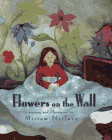
Flowers on the Wall
Focusing on Rachel, an eight-year old Jewish girl, living
in Warsaw, Poland in 1938, this is the moving, heartbreaking
story of a family's sacrifices, fear and pain. Somber
watercolors personalize the valiant struggle for beauty,
sunshine and survival. This lengthy picture book may be
the perfect choice for reluctant readers who find
The
Diary of Anne Frank or
Number
the Stars too difficult to read independently.
Description from Children's Literature
Stories about the Holocaust for young children always
raise problems: either they tell the terrifying truth and that
can overwhelm this audience, or they distort the truth and make
things sweet and hopeful. This quiet picture book is neither
sensational nor comforting. Inspired by a pre-Holocaust
photograph by Roman Vishniac, Nerlove imagines the life of
a Jewish child in Warsaw who stayed in bed all winter because
of the cold and painted flowers on the wall behind her bed. Most
of the story takes place before the Nazi invasion, when the Jews
suffered under Polish oppression. For a brief period, Rachel
gets some shoes and even manages to go to school; then the
Germans come, and the final double-page spread shows the Jews
being taken to Treblinka concentration camp, Rachel's dreams
"gone forever." The words and watercolor pictures are understated,
avoiding close-up scenes of brutality, starvation, and
breakdown. The focus is on the rooms of home and school and
the brightly colored flowers that cover the cracked gray
walls.
Description from Booklist
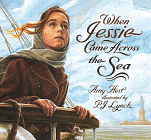
When Jessie Came Across the Sea
By Amy Hest
Jessie and her grandmother live in an Eastern European shtetel where, one
day, the Rabbi informs the villagers that his brother has died and left
him one ticket to "the promised land." The rabbi feels he cannot leave
his people and decides to give the ticket to 13-year-old Jessie. It's
almost too much for Jessie and her grandmother to bear, though both
believe it is for the best. In America, Jessie follows her grandmother's
trade and becomes a dressmaker. She works for three years until she has
enough saved to purchase another ticket--for her grandmother. This picture
book for older children is handsomely crafted. The pages are thick, and the
watercolor-and-gouache paintings that illustrate the story are luminous.
Lynch's full-page and paneled art, especially the scenes of Jessie at sea,
have a panoramic quality. The pictures are striking, but it's the text that
conveys the human emotions of loss, hope, and love that children will
respond to.
Description from Booklist
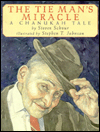
The Tie Man's Miracle :
A Chanukah Story
Chanukah, the Jewish celebration of miracles, is a wonderfully fitting
backdrop for this unquestionably sentimental but beautifully told story
of little wonders. The arrival of elderly Mr. Hoffman, who sells ties
from a cardboard box he carries with him, makes seven-year-old Seth
impatient. It's the last night of Chanukah, and Seth wants to get on
with the traditional lighting of the candles. But Seth's parents -- wise,
kind, and not so hurried -- urge the old man to join their celebrations.
Mr. Hoffman stays and, in answering Seth's nosy questions about his
family, explains about the Holocaust and tells a legend that stretches
back to his boyhood: if all nine candles on the menorah burn down
at the same time, a wish will travel "straight to the ear of G-d."
Schnur leaves plenty of room for adults to introduce information
about the Holocaust (which he describes only as "a terrible war" ) to
children if they feel the time is right, and although there's a sense of
miracles in the making (as expected, the candles burn down together),
there's no pushy resolution: Seth is left to wonder whether, indeed, his
generous wish for the old man really comes true. Johnson's fluid
watercolors are really quite fine, giving all the characters, especially
Mr. Hoffman, substance, individuality, and dignity. Not simply a book
about the holiday, this quiet, heartfelt, affirmative intergenerational story
speaks to the bonds that hold us all fast and to our belief in miracles.
Ideal for lap sharing and for using with small groups.
Description from Booklist
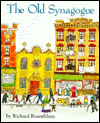
The Old Synagogue
A once-beautiful synagogue on a crowded street in a big
city is abandoned and becomes a factory when the original
neighborhood inhabitants become more prosperous and
move away; but as time goes by young Jewish families
rediscover the area, move in, and restore to beauty the
old synagogue.
Description from Publisher
Rosenblum describes the history of a small synagogue founded
by European Jews in a Bronx-like American neighborhood
in the late 1800s. He tells, through narrative and illustrations,
of the synagogue's dwindling membership due to changes
in the neighborhood and the consequent sale of the building,
and then of the contemporary restoration of both neighborhood
and synagogue. His two-page miniature pen-and-ink drawings
brim with the costumes, customs, and essence of daily life in the
neighborhood that he describes. Indeed, the illustrations detail
the changing neighborhood more thoroughly than does the text.
This slight picture book offers both nostalgic reminiscence and
evidence of urban change with a simplicity that holds meaning
even for young children.
Description from School Library Journal
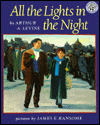
All the Lights in the Night
Based on the experiences of his grandfather and great-uncle's escape
from Russia in 1914, Levine's story of two courageous boys should
appeal to children. It is almost Hanukkah when brothers Moses and
Benjamin flee the pogroms in their small village for Palestine,
where their older brother lives. They travel by cart, train, and
finally ship, through a number of trials and dangers. Along the way
their spirits are sustained by telling the story of Hanukkah to each
other, and by their grandmother's lamp. Given to them by their mother
with only enough oil to last for a single night, it recreates the
Hanukkah miracle by providing enough light for the entire journey.
When the captain of the ship on which they are to sail claims they
have only enough money for one ticket, they pay for the second ticket
with the lamp. The boys mourn its loss, but then realize that they
have All the Lights in the Night. Ransome's oil paintings
capture the drama of the journey, especially the boys' encounters
with the train conductor and the sea captain. They also show the
warm relationship between the brothers. Good to read aloud, the
story should prove popular for intergenerational sharing, especially
in families in which grandparents or great-grandparents emigrated
at a young age.
Description from School Library Journal
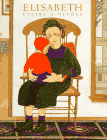
Elisabeth
Illustrator Nivola (The Disobedient Eels) proves herself a sure-handed
storyteller with this moving, true story from her mother's life. The narrator,
remembering her girlhood in Germany, describes her doll Elisabeth ("We
loved each other so dearly that we shared everything"). But after the
Nazis rise to power, she and her parents flee, leaving everything behind --
including Elisabeth. Decades later in the United States, she joyfully finds
Elisabeth in an antiques store. Elisabeth then passes from mother to
daughter to granddaughter, and "sometimes we wonder together -- as
I'm sure you will-how Elisabeth came to find me and mend my heart
after so many years and across such a wide ocean." Enlivened by quirky
anecdotes (such as the narrator's dog Fifi dragging Elisabeth around "to
dance" -- and thereby leaving teeth marks for later identification), the
text floats smoothly atop the story's dark undercurrents, further buoyed
by Nivola's radiant and tender illustrations. Though generously detailed
with atmospheric particulars, her paintings never lose their focus on the
protagonist's deep emotions. A story that will linger in the reader's heart.
Description from Publisher's Weekly

Grandmother and the Runaway Shadow
By Liz Rosenberg
Based on the author's and the illustrator's own family immigration
stories, this picture book tells of a young Jewish woman coming to
America to escape persecution in Eastern Europe around the turn of
the century. "When my grandmother came to this country, a runaway
shadow came with her." Her shadow gives her courage, makes her laugh,
and shares her memories as she runs from her village, crosses the
ocean, and finds a home, work, and friends in America. The idea of
a secret companion will appeal to children, but the repeated mention
of the shadow on every single page is overdone, especially since the
immigrant story is drama enough. The oil paintings, in shades of brown,
with rhythmic, sweeping lines, capture the vitality of the period, the
flowing crowds in the tenement streets, the workers in the garment
factory, and the brave young woman who finds in herself--in her own
shadow--the strength for her journey. There's a story like this in
nearly every family.
Description from Booklist
In the old days, times were tough: Cossacks would ride into villages,
shouting and waving torches. Things were so bad that even the shadows
wanted to run away. When the author's grandmother and her shadow met
up one night in the middle of a potato field, it didn't take long for
the two of them to decide to go to America. Weaving together a touching
story and engaging illustrations, Rosenberg and Peck tell a beautiful
tale of a young girl's long and difficult journey and of the special
friend who kept her from ever being completely alone.
Description from Children's Literature

Introducing Shirley Braverman
By Hilma Wolitzer
The adventures of a sixth-grader growing up in Brooklyn during World War II.
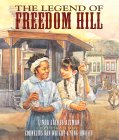
The Legend of Freedom Hill
By Linda Jacobs Altman
In California in the 1850s, an African-American girl teams up with a Jewish
girl in a search for gold to save the black girl's mother from a slavecatcher.
Through perseverance, the two friends find enough gold to buy the freedom
of all the captured slaves. Using accurate details and lively language, this tale
of love, bravery, and friendship evokes a colorful era.
Description from Publisher
With a country-style conversational tone, Altman has written a delightful tale about the friendship between an African-American and a Jewish girl during the California Gold Rush. When Rosabel's mother is kidnapped by a slave-catcher, Rosabel goes to her friend Sophie's house. They immediately welcome her into their home, where she joins them for a Sabbath dinner and stays at their house overnight, where the two girls are determined to come up with a way to rescue Rosabel's mother. They eventually discover a gold mine that has gone unnoticed because it is too small for adults to enter. Altman gives a warm treatment to a topic rarely discussed in children's picture books. Watercolor illustrations emphasizing earth tones give the story a more authentic feel. An excellent story to bridge to discussions about history or simply to focus on a wonderful friendship.
Lori's Description

On the Wings of Eagles : An Ethiopian Child's Story
A Jewish Ethiopian boy recounts the story of Israel's 1991 airlift rescue of his threatened people.
Description from Publisher
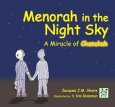
Menorah in the Night Sky
By Jaques J. M. Shore
A beautifully illustrated children's book, Menorah in the Night Sky draws on the miraculous events of Chanukah - the Festival of Lights - and tells the meaningful, yet simple story of two young boys, best friends in a lonely camp during the Holocaust, who discover their own Chanukah miracle. Looking to the stars each night, to provide the spark of light in place of the nightly Menorah candle, the two boys learn the value of hope and the miracle of faith.
A story of friendship and light, full of warmth and hope, richly illustrated and vividly told, Menorah in the Night Sky brings to life Zev and David, and their hopes and dreams, in a way that all children, and their parents too, will enjoy.
Description from Publisher

I Am Jewish American
By Elizabeth Weitzman
Rachel, a young girl living in Chicago, offers her perspective on the history, beliefs, and life style of her Jewish American community. In one-page chapters she touches on the reasons her grandmother's family left Eastern Europe, their journey to America, and their adjustment to a new land. She introduces topics such as the Sabbath, respect for learning, traditional foods, and her family's strong emotional and spiritual ties to Israel. Unfortunately, the author's use of the term "Wailing Wall" is no longer widely accepted; the preferred designation among Jews is now "Western Wall." The religious denomination represented is not identified, but a traditional, though not necessarily Orthodox, orientation is indicated. An informative full-color or sepia photograph faces each page of text. A useful and accessible book for children of all backgrounds.
Description from School Library Journal

Immigrant Girl :
Becky of Eldridge Street
By Brett Harvey
Ten-year-old Becky Moscowitz has come from rural Russia to
live in the noisy, crowded Lower East Side of New York City
in 1910. She has settled into a three room flat with her Mama,
Papa, two brothers, one sister, grandmother, aunt, and a boarder.
She has many new experiences -- learning the English language
at school, playing street games, going to the Nickelodeon,
shopping at the market on Hester Street, visiting a library. In
addition to providing a delightful "slice of life'' book about
turn-of-the-century Jewish immigration, Harvey and Ray also
provide young audiences with a bit of historical information
about pogroms, sweatshops, and Jewish religious traditions. A
glossary of unfamiliar terms further enhances the book's utility.
Numerous soft black-and-white drawings combine perfectly
with the well characterized text to yield a warm, interesting
glimpse of the past -- one not often available to readers of this
age group.
Description from School Library Journal
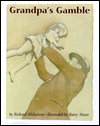
Grandpa's Gamble
Grandpa, a Polish Jew who fled the ghettos and pogroms and came to
America early in this century, now lives with his grown daughter and
her family. His two grandchildren yearn for a more exciting relative, but
the man is always davening (praying) and cannot be disturbed. When
the youngsters come across an old photograph, Grandpa Sam tells
about his past. Once proud and handsome, he gambled his way into
major wealth until one Passover eve when his young daughter became
sick. Betting everything on Gods mercy, Sam vowed to pray every
morning and evening for the rest of his life. Miracle of miracles, she
got better. An authors note explains unfamiliar words (afikoman,
yarmulke, etc.). Executed on handmade antique paper, Mosers full-page,
realistic drawings in warm sepia washes are beautifully done. The book
is handsomely designed with crisp white borders surrounding the ecru
paper, highlighting its ragged edges.
Description from School Library Journal
Michelson's story is both personal and universal, highlighting the
discovery of family histories and hidden lives in people who are so much a
part of every day. Moser's skilled sepia illustrations add an intimate touch
to this poignant tale.
Description from Kirkus Reviews
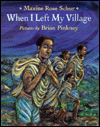
When I Left My Village
This companion to Schur's Day
of Delight follows a family of Ethiopian
Jews (the Beta Israel) in their escape from drought and persecution. Traveling
at night on foot through mountains, plains, and desert, 12-year-old Menelik,
his parents, and younger brother head for a Sudanese refugee camp. From
there, the people are airlifted to Israel; given homes, clothing, and food; and
assimilated into a culture that offers them freedom, safety, and equality. The
boy tells the story of the perilous journeyof days filled with hunger, fear of
discovery, and death; of a furtive border crossing; of weeks of unsanitary
living in the crowded camp; and, finally, of resettlement in a small white hut
in the hills near Jerusalem. The book reads like a true adventure story. Pinkney's
full-page, black-and-white scratchboard illustrations add reality to this
fictionalized account of the recent rescue mission that saved the remnants of
a little-known civilization. A map of the Middle East shows the family's escape
route, and an author's note adds historical information.
Description from School Library Journal
Winner of The Sydney Taylor Award (The Association of Jewish Libraries)
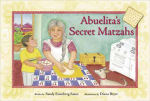
Abuelita's Secret Matzahs
By Sandy Eisenberg Sasso
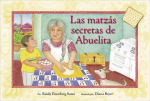
Spanish Edition Also Available
Abuelita's Secret Matzahs tells the fascinating but little-known story of the Cryptojews, Jews forced to convert to Christianity during the Spanish Inquisition who secretly maintained their Jewish faith and customs throughout the ages — often revealing the secret to only one person per generation.
Jacobo loves to visit his grandmother, "Abuelita," who lives in Santa Fe, New Mexico, in an adobe house hidden by juniper and pinon trees. When Jacobo befriends David, a Jewish child, he starts to notice that David's family observes many of the same traditions as Jacobo's grandmother: they avoid pork, they light two candles on Friday nights, and they eat unleavened bread during Passover. When Jacobo asks Abuelita about this discovery, she offers him the chance to be the keeper of traditions for his generation - and Jacobo realizes that he will one day have to make a choice between the Christian beliefs he has been raised with and the Judaism of his ancestors.
Like life, Abuelita's Secret Matzahs offers no easy answers about what Jacobo's choice will be; parents and children will find here an opportunity to discuss their own family traditions and history.
Desciption from Publisher
Page 1 |
Page 2 |
Page 3 |
Page 4
Still can't find what you're looking for? Search Amazon.com's database directly.
©1999-2009
(NOTE: The following links have NOT been placed on the site by the website owners. We have no control over which ads are selected and are not responsible for their religious content.)
If this page came up without frames, Click here to see the complete website
For history books for older readers, go to the History Books for Middle School and YA Readers Page
For historical fiction books for older readers, go to the Historical Fiction Books for Middle School and YA Readers Page
Other Pages of Interest:
Children's Jewish History and Historical Fiction Books
(Page 1) |
(Page 2) |
(Page 3) |
(Page 4) |
Easy Reader and Picture Books:
Jewish Children's Books (General) |
Jewish Board Books |
Biblical Stories for Children |
Jewish Holiday Books |
Jewish Family Cookbooks |
Folktales and Talmudic Stories for Children |
Jewish Life Books (Mitzvot, Keeping Kosher, etc.) |
Jewish Life Cycle Books |
Family Haggadahs |
Children's Prayerbooks |
Introductory Hebrew Books |
Jewish History and Historical Fiction Picture Books |
Israel Books
Middle School and YA Books:
Bar Mitzvah Books |
Jewish Fiction |
Historical Fiction |
Torah Study |
Prayer and Jewish Life Books |
Jewish Holidays |
Jewish Biographies |
Jewish History Books |
Holocaust Books for Teens |
Israel Books
Jewish Children's Books |
Bar Mitzvah Books |
Jewish Parenting Books |
Jewish Music for Children |
Jewish Children's Videos |
Jewish Jewelry
Other Pages of Interest:
Children's Jewish History and Historical Fiction Books
(Page 1) |
(Page 2) |
(Page 3) |
(Page 4) |
Easy Reader and Picture Books:
Jewish Children's Books (General) |
Jewish Board Books |
Biblical Stories for Children |
Jewish Holiday Books |
Jewish Family Cookbooks |
Folktales and Talmudic Stories for Children |
Jewish Life Books (Mitzvot, Keeping Kosher, etc.) |
Jewish Life Cycle Books |
Family Haggadahs |
Children's Prayerbooks |
Introductory Hebrew Books |
Jewish History and Historical Fiction Picture Books |
Israel Books
Middle School and YA Books:
Bar Mitzvah Books |
Jewish Fiction |
Historical Fiction |
Torah Study |
Prayer and Jewish Life Books |
Jewish Holidays |
Jewish Biographies |
Jewish History Books |
Holocaust Books for Teens |
Israel Books
Jewish Children's Books |
Bar Mitzvah Books |
Jewish Parenting Books |
Jewish Music for Children |
Jewish Children's Videos |
Jewish Jewelry
Easy Reader and Picture Books:
Jewish Children's Books (General) | Jewish Board Books | Biblical Stories for Children | Jewish Holiday Books | Jewish Family Cookbooks | Folktales and Talmudic Stories for Children | Jewish Life Books (Mitzvot, Keeping Kosher, etc.) | Jewish Life Cycle Books | Family Haggadahs | Children's Prayerbooks | Introductory Hebrew Books | Jewish History and Historical Fiction Picture Books | Israel Books
Middle School and YA Books:
Bar Mitzvah Books | Jewish Fiction | Historical Fiction | Torah Study | Prayer and Jewish Life Books | Jewish Holidays | Jewish Biographies | Jewish History Books | Holocaust Books for Teens | Israel Books
Jewish Children's Books | Bar Mitzvah Books | Jewish Parenting Books | Jewish Music for Children | Jewish Children's Videos | Jewish Jewelry
 Buba Leah and Her Paper Children By Lillian Hammer Ross |
With its Fiddler on the Roof setting and unabashedly
sentimental story line, this warmly evocative tale presents
a glimpse of the Jewish immigrant experience. Chava is
curious about her next-door neighbor and great-aunt,
Buba Leah. She's often heard her say how she exchanged
her offspring for "paper children.'' When Chava finally
musters her courage to ask about them, she finds they
aren't actual children, but the letters written to Buba Leah
by her children in America. One day a letter arrives containing
two tickets--one for Buba Leah and one for Chava--and,
in a poignant finale, the two depart for a new life. Chava's
parents are left with Buba Leah's empty wooden box,
which they will soon fill with their own "paper children.''
Ross's simple story is as satisfying as Sabbath challah,
and Morgan's earthy illustrations render village life and
the special bonds between family members in an
affectionate light.
|
 The Journey That Saved Curious George : The True Wartime Escape of Margret and H.A. Rey By Louise Borden |
Everybody loves Curious George, the mischievous monkey, but few know the harrowing story behind his creators' narrow escape from Paris just hours before the Nazis seized control of the city. In 1940, Hans and Margret Rey had to flee their home as the German army advanced. They began their journey to freedom on bicycles, pedaling to southern France with their children's book manuscripts among their few possessions. One of these manuscripts went on to become Curious George, the tale of that inquisitive monkey who is one of the most enduring characters in children's literature. The Reys' story is now told in dramatic detail in The Journey That Saved Curious George.
Louise Borden combed primary resources, including Hans Rey's pocket diaries, to tell this dramatic story. Archival materials — photographs, train ticket stubs, letters and cards — introduce readers to the world of Hans and Margret Rey, and Allan Drummond dramatically and colorfully illustrates their wartime trek to a new home. Follow the Reys' amazing story in this unique large-format book that resembles a travel journal; see for yourself the route the Reys took as they traveled to freedom. A new book, The Journey That Saved Curious George: The True Wartime Escape of Margret and H. A. Rey", tells of how George's creators, both German-born Jews, fled from Paris by bicycle in June 1940, carrying the manuscript of what would become Curious George as Nazis prepared to invade. ... Her account, intended for older children, is illustrated in whimsical European style by Allan Drummond, and includes photographs of the Reys and wartime Europe, as well as H. A. Rey's pocket diaries and transit documents. |
 Always Remember Me: How One Family Survived World War II By Marisabina Russo |
Awards:
Rachel's Oma (her grandmother) has two picture albums. In one the photographs show only happy times -- from after World War II, when she and her daughters had come to America. But the other album includes much sadder times from before -- when their life in Germany was destroyed by the Nazis' rise to power.
For as long as Rachel can remember, Oma has closed the other album when she's gotten to the sad part. But today Oma will share it all. Today Rachel will hear about what her grandmother, her mother, and her aunts endured. And she'll see how the power of this Jewish family's love for one another gave them the strength to survive. Marisabina Russo illuminates a difficult subject for young readers with great sensitivity. Based on the author's own family history, Always Remember Me is a heartbreaking -- and inspiring -- book sure to touch anyone who reads it. The experiences of Russo's relatives before, during, and after World War II are the basis for this story about a grandmother sharing with her young granddaughter photo albums of her "first life" (in Germany) and her "second life" (after the war). Rachel's family gathers for Sunday dinner at Oma's. After the meal, Oma tells the girl of her marriage and her family's happy life; her husband's death after World War I; the rise of the Nazi party and denial of rights to Jews; the burning and looting of Jewish businesses; and life in a concentration camp. At war's end, Oma and her three daughters were reunited in America. Now she gives Rachel the gold heart necklace that her own grandmother gave her many years ago when her family left Poland for Germany ("When you wear this…always remember me and…May luck follow you wherever you go"). This book introduces the Holocaust in a simple but factual narrative that can be easily understood by youngsters who have no knowledge of World War II. Gouache illustrations in Russo's familiar folk style are accompanied by many re-creations of old photos, government papers, money, an identity card–all helping to bring the events to life. Photos on the endpapers show the author's family. This offering answers the need for appropriate Holocaust literature for young children and should be considered a first purchase. In a moving picture book, Russo tells her Jewish family's story of Holocaust survival. She remembers herself as a small child visiting her grandmother, Oma, who tells Russo the family history with photos stretching back to Oma's youth and marriage before World War I. Children will need help to understand the multigenerational time frame and to keep track of who's who; in fact, the book may appeal more to adults than to young readers. But Russo personalizes the history with photo-album entries printed on the endpapers, and her gouache illustrations, framed like photos, show the individuality and strength of family members as they faced the Nazis who sought to destroy all Jews. Miraculously, Oma and her three daughters, two of whom were in the camps, survived to be reunited in the U.S. An afterword fills in some Holocaust history. |
 One Yellow Daffodil : A Hanukkah Story |
Awards:
What a beautifully written story about the rekindling of light in the life of a
Holocaust survivor! Morris Kaplan leads a quiet existence, surrounded
by the beautiful blossoms in his shop and looking forward only to the
frequent visits of Ilana and Jonathan, who buy flowers for Shabbat and
special occasions. He shows his appreciation by loading them up with far
more bouquets than their few dollars could actually purchase; they reciprocate
by inviting him to celebrate Hanukkah with their family. The warmth and
joy of their holiday observance melts the ice which has long encased his
sad memories, and Morris himself blooms again, as did the flower of the
title in the dark days of Auschwitz. The pictures are stunning, from deepest
darks to glorious lights, and the tilted faces lend a legendary quality to this
touching tale.
This understated picture book effectively tells the story of a Holocaust survivor in a subtle way that doesn't overwhelm young children. Morris Kaplan is a Holocaust survivor who runs a neighborhood flower shop. He befriends Ilana and Jonathan Becker who invite him to their house to celebrate Hanukkah. He hasn't celebrated Hanukkah since his childhood in Poland, but Ilana and Jonathan won't accept "no" for an answer. They light candles, sing songs, play dreidels, and chat after dinner. The evening inspires Morris to take out the menorah that belonged to his family. He thinks about life in Auschwitz and about how a yellow daffodil gave him the strength to survive; if a flower can survive in such a dark place, so could he. He brings his menorah and tells his story to the Beckers who give him his first sense of family since the Holocaust. David Adler brings an emotional story to a young audience. The horrors of the Holocaust are only hinted at, but children can grasp the concept that it was a sad time. The dark, mu/ed watercolors convey the depth of emotions Morris feels. |
 Flowers on the Wall |
Focusing on Rachel, an eight-year old Jewish girl, living
in Warsaw, Poland in 1938, this is the moving, heartbreaking
story of a family's sacrifices, fear and pain. Somber
watercolors personalize the valiant struggle for beauty,
sunshine and survival. This lengthy picture book may be
the perfect choice for reluctant readers who find
The
Diary of Anne Frank or
Number
the Stars too difficult to read independently.
Stories about the Holocaust for young children always raise problems: either they tell the terrifying truth and that can overwhelm this audience, or they distort the truth and make things sweet and hopeful. This quiet picture book is neither sensational nor comforting. Inspired by a pre-Holocaust photograph by Roman Vishniac, Nerlove imagines the life of a Jewish child in Warsaw who stayed in bed all winter because of the cold and painted flowers on the wall behind her bed. Most of the story takes place before the Nazi invasion, when the Jews suffered under Polish oppression. For a brief period, Rachel gets some shoes and even manages to go to school; then the Germans come, and the final double-page spread shows the Jews being taken to Treblinka concentration camp, Rachel's dreams "gone forever." The words and watercolor pictures are understated, avoiding close-up scenes of brutality, starvation, and breakdown. The focus is on the rooms of home and school and the brightly colored flowers that cover the cracked gray walls. |
 When Jessie Came Across the Sea By Amy Hest |
Jessie and her grandmother live in an Eastern European shtetel where, one
day, the Rabbi informs the villagers that his brother has died and left
him one ticket to "the promised land." The rabbi feels he cannot leave
his people and decides to give the ticket to 13-year-old Jessie. It's
almost too much for Jessie and her grandmother to bear, though both
believe it is for the best. In America, Jessie follows her grandmother's
trade and becomes a dressmaker. She works for three years until she has
enough saved to purchase another ticket--for her grandmother. This picture
book for older children is handsomely crafted. The pages are thick, and the
watercolor-and-gouache paintings that illustrate the story are luminous.
Lynch's full-page and paneled art, especially the scenes of Jessie at sea,
have a panoramic quality. The pictures are striking, but it's the text that
conveys the human emotions of loss, hope, and love that children will
respond to.
|
 The Tie Man's Miracle : A Chanukah Story |
Chanukah, the Jewish celebration of miracles, is a wonderfully fitting
backdrop for this unquestionably sentimental but beautifully told story
of little wonders. The arrival of elderly Mr. Hoffman, who sells ties
from a cardboard box he carries with him, makes seven-year-old Seth
impatient. It's the last night of Chanukah, and Seth wants to get on
with the traditional lighting of the candles. But Seth's parents -- wise,
kind, and not so hurried -- urge the old man to join their celebrations.
Mr. Hoffman stays and, in answering Seth's nosy questions about his
family, explains about the Holocaust and tells a legend that stretches
back to his boyhood: if all nine candles on the menorah burn down
at the same time, a wish will travel "straight to the ear of G-d."
Schnur leaves plenty of room for adults to introduce information about the Holocaust (which he describes only as "a terrible war" ) to children if they feel the time is right, and although there's a sense of miracles in the making (as expected, the candles burn down together), there's no pushy resolution: Seth is left to wonder whether, indeed, his generous wish for the old man really comes true. Johnson's fluid watercolors are really quite fine, giving all the characters, especially Mr. Hoffman, substance, individuality, and dignity. Not simply a book about the holiday, this quiet, heartfelt, affirmative intergenerational story speaks to the bonds that hold us all fast and to our belief in miracles. Ideal for lap sharing and for using with small groups. |
 The Old Synagogue |
A once-beautiful synagogue on a crowded street in a big
city is abandoned and becomes a factory when the original
neighborhood inhabitants become more prosperous and
move away; but as time goes by young Jewish families
rediscover the area, move in, and restore to beauty the
old synagogue.
Rosenblum describes the history of a small synagogue founded by European Jews in a Bronx-like American neighborhood in the late 1800s. He tells, through narrative and illustrations, of the synagogue's dwindling membership due to changes in the neighborhood and the consequent sale of the building, and then of the contemporary restoration of both neighborhood and synagogue. His two-page miniature pen-and-ink drawings brim with the costumes, customs, and essence of daily life in the neighborhood that he describes. Indeed, the illustrations detail the changing neighborhood more thoroughly than does the text. This slight picture book offers both nostalgic reminiscence and evidence of urban change with a simplicity that holds meaning even for young children. |
 All the Lights in the Night |
Based on the experiences of his grandfather and great-uncle's escape
from Russia in 1914, Levine's story of two courageous boys should
appeal to children. It is almost Hanukkah when brothers Moses and
Benjamin flee the pogroms in their small village for Palestine,
where their older brother lives. They travel by cart, train, and
finally ship, through a number of trials and dangers. Along the way
their spirits are sustained by telling the story of Hanukkah to each
other, and by their grandmother's lamp. Given to them by their mother
with only enough oil to last for a single night, it recreates the
Hanukkah miracle by providing enough light for the entire journey.
When the captain of the ship on which they are to sail claims they
have only enough money for one ticket, they pay for the second ticket
with the lamp. The boys mourn its loss, but then realize that they
have All the Lights in the Night. Ransome's oil paintings
capture the drama of the journey, especially the boys' encounters
with the train conductor and the sea captain. They also show the
warm relationship between the brothers. Good to read aloud, the
story should prove popular for intergenerational sharing, especially
in families in which grandparents or great-grandparents emigrated
at a young age.
|
 Elisabeth |
Illustrator Nivola (The Disobedient Eels) proves herself a sure-handed
storyteller with this moving, true story from her mother's life. The narrator,
remembering her girlhood in Germany, describes her doll Elisabeth ("We
loved each other so dearly that we shared everything"). But after the
Nazis rise to power, she and her parents flee, leaving everything behind --
including Elisabeth. Decades later in the United States, she joyfully finds
Elisabeth in an antiques store. Elisabeth then passes from mother to
daughter to granddaughter, and "sometimes we wonder together -- as
I'm sure you will-how Elisabeth came to find me and mend my heart
after so many years and across such a wide ocean." Enlivened by quirky
anecdotes (such as the narrator's dog Fifi dragging Elisabeth around "to
dance" -- and thereby leaving teeth marks for later identification), the
text floats smoothly atop the story's dark undercurrents, further buoyed
by Nivola's radiant and tender illustrations. Though generously detailed
with atmospheric particulars, her paintings never lose their focus on the
protagonist's deep emotions. A story that will linger in the reader's heart.
|
 Grandmother and the Runaway Shadow By Liz Rosenberg |
Based on the author's and the illustrator's own family immigration
stories, this picture book tells of a young Jewish woman coming to
America to escape persecution in Eastern Europe around the turn of
the century. "When my grandmother came to this country, a runaway
shadow came with her." Her shadow gives her courage, makes her laugh,
and shares her memories as she runs from her village, crosses the
ocean, and finds a home, work, and friends in America. The idea of
a secret companion will appeal to children, but the repeated mention
of the shadow on every single page is overdone, especially since the
immigrant story is drama enough. The oil paintings, in shades of brown,
with rhythmic, sweeping lines, capture the vitality of the period, the
flowing crowds in the tenement streets, the workers in the garment
factory, and the brave young woman who finds in herself--in her own
shadow--the strength for her journey. There's a story like this in
nearly every family.
In the old days, times were tough: Cossacks would ride into villages, shouting and waving torches. Things were so bad that even the shadows wanted to run away. When the author's grandmother and her shadow met up one night in the middle of a potato field, it didn't take long for the two of them to decide to go to America. Weaving together a touching story and engaging illustrations, Rosenberg and Peck tell a beautiful tale of a young girl's long and difficult journey and of the special friend who kept her from ever being completely alone. |
 Introducing Shirley Braverman By Hilma Wolitzer |
The adventures of a sixth-grader growing up in Brooklyn during World War II. |
 The Legend of Freedom Hill By Linda Jacobs Altman |
In California in the 1850s, an African-American girl teams up with a Jewish
girl in a search for gold to save the black girl's mother from a slavecatcher.
Through perseverance, the two friends find enough gold to buy the freedom
of all the captured slaves. Using accurate details and lively language, this tale
of love, bravery, and friendship evokes a colorful era.
With a country-style conversational tone, Altman has written a delightful tale about the friendship between an African-American and a Jewish girl during the California Gold Rush. When Rosabel's mother is kidnapped by a slave-catcher, Rosabel goes to her friend Sophie's house. They immediately welcome her into their home, where she joins them for a Sabbath dinner and stays at their house overnight, where the two girls are determined to come up with a way to rescue Rosabel's mother. They eventually discover a gold mine that has gone unnoticed because it is too small for adults to enter. Altman gives a warm treatment to a topic rarely discussed in children's picture books. Watercolor illustrations emphasizing earth tones give the story a more authentic feel. An excellent story to bridge to discussions about history or simply to focus on a wonderful friendship. |
 On the Wings of Eagles : An Ethiopian Child's Story |
A Jewish Ethiopian boy recounts the story of Israel's 1991 airlift rescue of his threatened people.
|
 Menorah in the Night Sky By Jaques J. M. Shore |
A beautifully illustrated children's book, Menorah in the Night Sky draws on the miraculous events of Chanukah - the Festival of Lights - and tells the meaningful, yet simple story of two young boys, best friends in a lonely camp during the Holocaust, who discover their own Chanukah miracle. Looking to the stars each night, to provide the spark of light in place of the nightly Menorah candle, the two boys learn the value of hope and the miracle of faith.
A story of friendship and light, full of warmth and hope, richly illustrated and vividly told, Menorah in the Night Sky brings to life Zev and David, and their hopes and dreams, in a way that all children, and their parents too, will enjoy. |
 I Am Jewish American By Elizabeth Weitzman |
Rachel, a young girl living in Chicago, offers her perspective on the history, beliefs, and life style of her Jewish American community. In one-page chapters she touches on the reasons her grandmother's family left Eastern Europe, their journey to America, and their adjustment to a new land. She introduces topics such as the Sabbath, respect for learning, traditional foods, and her family's strong emotional and spiritual ties to Israel. Unfortunately, the author's use of the term "Wailing Wall" is no longer widely accepted; the preferred designation among Jews is now "Western Wall." The religious denomination represented is not identified, but a traditional, though not necessarily Orthodox, orientation is indicated. An informative full-color or sepia photograph faces each page of text. A useful and accessible book for children of all backgrounds.
|
 Immigrant Girl : Becky of Eldridge Street By Brett Harvey |
Ten-year-old Becky Moscowitz has come from rural Russia to
live in the noisy, crowded Lower East Side of New York City
in 1910. She has settled into a three room flat with her Mama,
Papa, two brothers, one sister, grandmother, aunt, and a boarder.
She has many new experiences -- learning the English language
at school, playing street games, going to the Nickelodeon,
shopping at the market on Hester Street, visiting a library. In
addition to providing a delightful "slice of life'' book about
turn-of-the-century Jewish immigration, Harvey and Ray also
provide young audiences with a bit of historical information
about pogroms, sweatshops, and Jewish religious traditions. A
glossary of unfamiliar terms further enhances the book's utility.
Numerous soft black-and-white drawings combine perfectly
with the well characterized text to yield a warm, interesting
glimpse of the past -- one not often available to readers of this
age group.
|
 Grandpa's Gamble |
Grandpa, a Polish Jew who fled the ghettos and pogroms and came to
America early in this century, now lives with his grown daughter and
her family. His two grandchildren yearn for a more exciting relative, but
the man is always davening (praying) and cannot be disturbed. When
the youngsters come across an old photograph, Grandpa Sam tells
about his past. Once proud and handsome, he gambled his way into
major wealth until one Passover eve when his young daughter became
sick. Betting everything on Gods mercy, Sam vowed to pray every
morning and evening for the rest of his life. Miracle of miracles, she
got better. An authors note explains unfamiliar words (afikoman,
yarmulke, etc.). Executed on handmade antique paper, Mosers full-page,
realistic drawings in warm sepia washes are beautifully done. The book
is handsomely designed with crisp white borders surrounding the ecru
paper, highlighting its ragged edges.
Michelson's story is both personal and universal, highlighting the discovery of family histories and hidden lives in people who are so much a part of every day. Moser's skilled sepia illustrations add an intimate touch to this poignant tale. |
 When I Left My Village |
This companion to Schur's Day
of Delight follows a family of Ethiopian
Jews (the Beta Israel) in their escape from drought and persecution. Traveling
at night on foot through mountains, plains, and desert, 12-year-old Menelik,
his parents, and younger brother head for a Sudanese refugee camp. From
there, the people are airlifted to Israel; given homes, clothing, and food; and
assimilated into a culture that offers them freedom, safety, and equality. The
boy tells the story of the perilous journeyof days filled with hunger, fear of
discovery, and death; of a furtive border crossing; of weeks of unsanitary
living in the crowded camp; and, finally, of resettlement in a small white hut
in the hills near Jerusalem. The book reads like a true adventure story. Pinkney's
full-page, black-and-white scratchboard illustrations add reality to this
fictionalized account of the recent rescue mission that saved the remnants of
a little-known civilization. A map of the Middle East shows the family's escape
route, and an author's note adds historical information.
Winner of The Sydney Taylor Award (The Association of Jewish Libraries) |
 Abuelita's Secret Matzahs By Sandy Eisenberg Sasso  Spanish Edition Also Available |
Abuelita's Secret Matzahs tells the fascinating but little-known story of the Cryptojews, Jews forced to convert to Christianity during the Spanish Inquisition who secretly maintained their Jewish faith and customs throughout the ages — often revealing the secret to only one person per generation.
Jacobo loves to visit his grandmother, "Abuelita," who lives in Santa Fe, New Mexico, in an adobe house hidden by juniper and pinon trees. When Jacobo befriends David, a Jewish child, he starts to notice that David's family observes many of the same traditions as Jacobo's grandmother: they avoid pork, they light two candles on Friday nights, and they eat unleavened bread during Passover. When Jacobo asks Abuelita about this discovery, she offers him the chance to be the keeper of traditions for his generation - and Jacobo realizes that he will one day have to make a choice between the Christian beliefs he has been raised with and the Judaism of his ancestors. Like life, Abuelita's Secret Matzahs offers no easy answers about what Jacobo's choice will be; parents and children will find here an opportunity to discuss their own family traditions and history. |